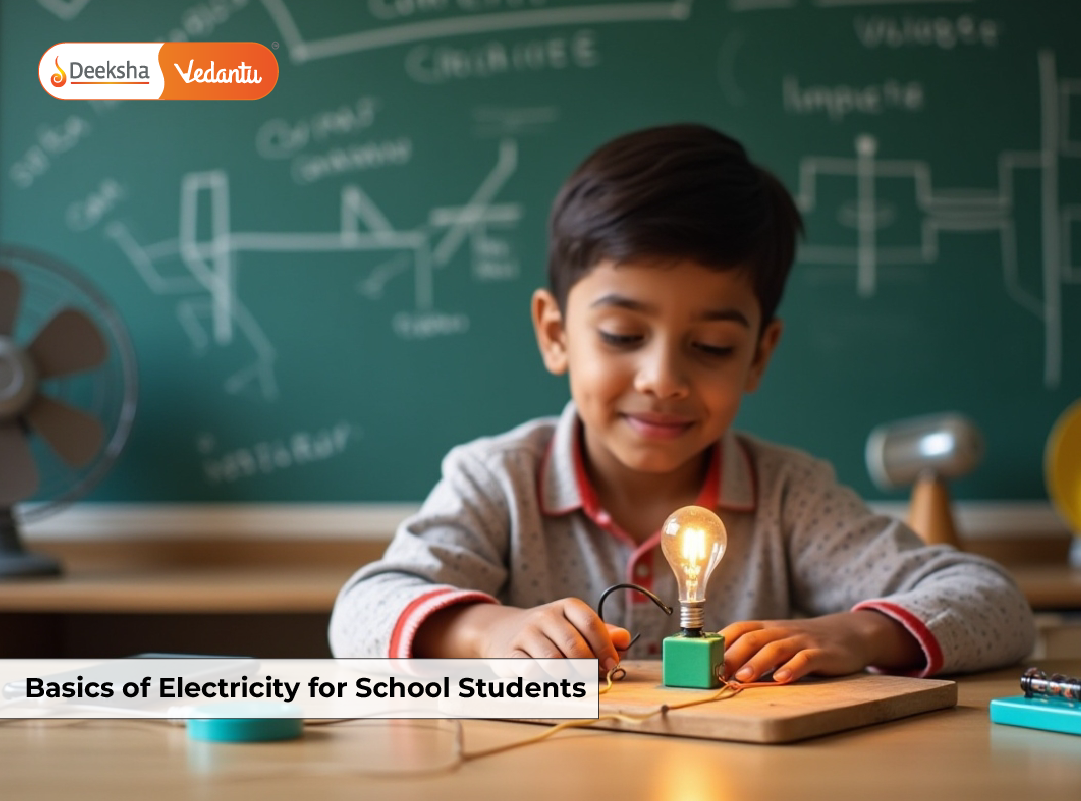Introduction
Electricity is one of the most important discoveries in human history. Imagine switching on a light in your room, charging your phone, or hearing music through your speaker — all these everyday actions involve the science of electricity. It powers everything from lights and fans to modern computers, electric vehicles, and advanced hospital equipment.
For school students, understanding the basics of electricity is not just about theory — it helps connect classroom learning to real-life experiences. It lays the foundation for future careers in science, engineering, and technology. This guide will explain electricity in simple terms: what electricity is, how it flows, key formulas, types of circuits, and real-world examples you encounter daily.
What is Electricity?
Electricity is the movement of electric charges, usually electrons, through a conductor. It’s a form of energy that can be easily converted into heat, light, mechanical energy, or chemical energy, making it incredibly useful in countless applications.
Important Terms to Understand
- Charge (Q): A basic property of particles like electrons (-) and protons (+), responsible for electric forces.
- Electric Current (I): The rate of flow of electric charge in a conductor. Measured in amperes (A).
- Voltage or Potential Difference (V): The driving force that pushes electric current through a circuit.
- Resistance (R): The opposition a material offers to the flow of current. Measured in ohms (Ω).
Understanding these terms is key to solving electrical problems and designing circuits.
Dive deeper here: Electric Current and Circuit
Electric Current and Its Formula
Electric current flows when there is a potential difference (voltage) across a conductor and a closed path for charges to move.
Electric Current Formula:
I = Q / t
Where:
- I = Current (in amperes)
- Q = Charge (in coulombs)
- t = Time (in seconds)
Example: If 12 C of charge flows through a wire in 4 seconds, the current is:
Measuring Current
Current is measured using an ammeter, which is always connected in series with the circuit components.
Also explore: Electric Potential and Potential Difference
Electric Circuit Basics
An electric circuit is a path through which electric current flows. A complete circuit includes a power source, conducting wires, and a load (e.g., a bulb).
Components of a Simple Circuit:
- Power Source (Battery): Supplies the voltage
- Conductors (Wires): Provide a path for current
- Load (Bulb, Resistor): Converts electrical energy into other forms
- Switch: Opens or closes the circuit
When the switch is closed, current flows and the load functions. If the switch is open, the circuit is broken and no current flows.
Check diagrams here: Circuit Diagram
Types of Circuits for Students
Learning how different circuits work is essential for practical applications and lab experiments. You’ll frequently use these in school labs and future projects.
1. Series Circuit
- All components are connected end-to-end
- Same current flows through every component
- One component failing breaks the entire circuit
- Uses: Decorative lights, torch circuits
2. Parallel Circuit
- Components connected across common points
- Voltage is the same across each branch
- If one component fails, others still work
- Uses: Household electrical wiring
3. Combination Circuit
- A mix of series and parallel components
- Offers both redundancy and voltage sharing
- Uses: Complex electronics, classrooms, homes
Visual learning aids can greatly help in understanding these configurations.
Ohm’s Law: The Core Principle
Ohm’s Law explains how voltage, current, and resistance are related in a conductor.
Ohm’s Law Formula:
V = I × R
Where:
- V = Voltage (volts)
- I = Current (amperes)
- R = Resistance (ohms)
Graphical Representation
If you plot current (I) on the Y-axis and voltage (V) on the X-axis, the slope of the straight line gives 1/R. This linear relationship holds for ohmic conductors like copper.
Heating Effect of Electric Current
When current flows through a conductor with resistance, it generates heat. This effect is known as the heating effect of electric current. It forms the basis of several electrical appliances.
Why It Happens
As electrons move through a resistor, they collide with atoms of the material. These collisions cause resistance, which converts some electrical energy into heat.
Applications:
- Electric Heaters: Convert electrical energy into heat
- Toasters and Geysers: Rely on heating coils
- Electric Fuses: Melt when current exceeds safe limits
Detailed insights: Heating Effect of Electric Current
Electric Power and Its Calculation
Electric power is the rate at which electric energy is consumed or produced. It helps us determine how much energy an appliance uses.
Power Formula:
P = V × I
Also derived as:
- P = I² × R
- P = V² / R
Where:
- P = Power (watts)
- V = Voltage (volts)
- I = Current (amperes)
- R = Resistance (ohms)
Example:
If a fan operates at 220V and draws 0.5A of current, power consumed is:
P = 220 × 0.5 = 110 W
Explore more here: Electric Power
Real-Life Examples of Electricity
Electricity is part of our everyday life. Here’s how:
Home Appliances
- Switching on a Light Bulb: Closes the circuit and converts electrical energy into light and heat
- Electric Kettle & Iron: Use the heating effect to boil water or press clothes
Electronics
- Mobile Chargers: Convert alternating current (AC) to direct current (DC) and regulate voltage
- Remote Controls: Use electric circuits to transmit infrared signals
Everyday Actions
- Touching Metal After Walking on Carpet: Static charge buildup discharges when touching metal
- Contactless Cards & RFID: Use circuits that get activated by nearby electromagnetic fields
Transportation
- Electric Scooters & Buses: Use stored electrical energy from batteries
- Traffic Lights: Controlled by microprocessors and circuit boards
Frequently Asked Questions
1. What is electricity in simple words?
Electricity is the flow of electric charges (usually electrons) through a conductor, powering devices and appliances.
2. What is the formula for electric current?
I = Q / t — Current equals charge divided by time.
3. What are the different types of electric circuits?
Series circuits, parallel circuits, and combination circuits.
4. What causes the heating effect of electric current?
When current flows through a resistor, it generates heat due to the material’s resistance.
5. How is electric power calculated?
Power = Voltage × Current or using Ohm’s Law: P = I²R or P = V²/R
6. Why do we use parallel circuits at home?
So that one device failing doesn’t affect others and each gets the same voltage.
Conclusion
Electricity is at the heart of modern civilization. From lighting up homes to running computers and operating life-saving machines, it touches every part of our daily lives. For students, understanding the basics of electricity builds a strong foundation for future learning in science and technology.
By grasping concepts like electric current, circuits, Ohm’s Law, and power calculations, you’ll be better equipped to excel in exams and apply your knowledge in practical settings.
For deeper explanations, diagrams, and animations, explore Deeksha Vedantu’s full suite of physics resources.
Table of Contents










Get Social